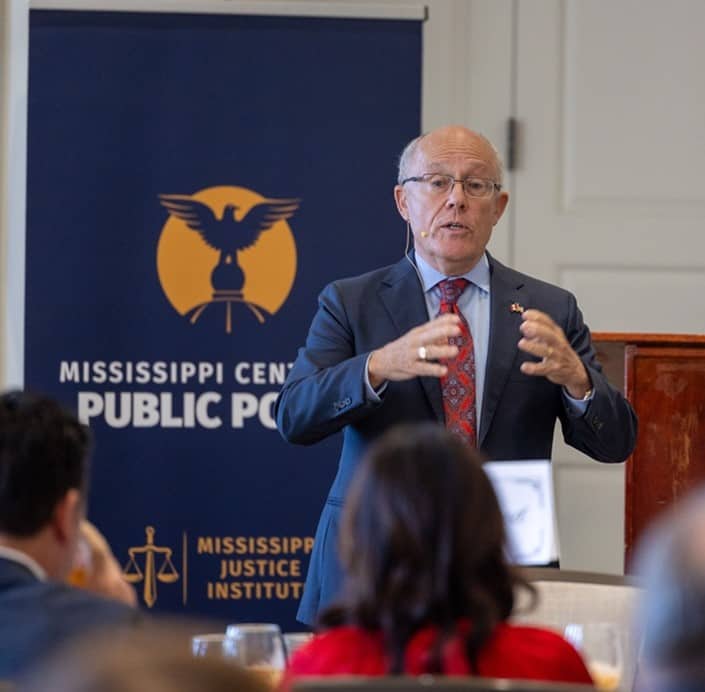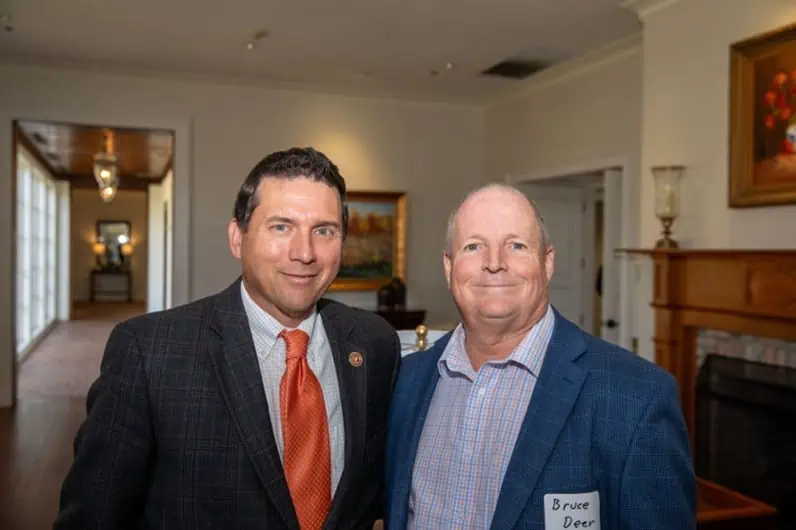Green energy – folly or the future?
Former White House energy adviser, Mark Mills, addressed at a packed lunch meeting in Jackson, Mississippi, at an event attended by key state policy makers and members of the public.
Mills, a senior fellow at the Manhattan Institute, talked about some of the implications of the rush to renewable energy. In order to meet net zero carbon dioxide emissions targets, Mark Mills outlined the scale of infrastructure construction that would be required.
“Mark Mills has an encyclopaedic knowledge about energy policy. He laid out some of the hard facts about what it would take to ditch our dependence on oil and gas.” said Douglas Carswell of the Mississippi Center for Public Policy.
“Mark Mills warned about making the same mistake that Germany has made. Over there, politicians rushed into renewable energy, and in doing so pushed up the cost of energy. This has now priced German industry out of the world market” Carswell added.
“If Mississippi wants to keep on attracting more industry, we need to ensure that we continue to have a plentiful supply of affordable energy”.
“Transitioning to renewables might sound like a bright idea in Washington DC” Carswell added. “Mark Mills showed that unless the federal government can change the laws of physics it is just not realistic. America would need to install thousands of new giant wind turbines each week, cover a vast area in solar panels and build dozens of new nuclear plants each year.”
“Politicians might talk glibly about moving to electric vehicles” he added. “Mark Mills pointed out that we would need hundreds of new charging stations, each one requiring the same amount of electricity as a steel mill. The capacity and infrastructure simply won’t be there to achieve this rush to renewables”.
The event was hosted jointly by Bigger Pie Forum and the Mississippi Center for Public Policy. Several members of the state legislature and Public Service Commissioners attended and asked questions.
To watch Mark Mills, talk online, click here:



The Inflation Reduction Act does nothing to reduce inflation. Seldom in America’s history has there been a piece of legislation put before Congress so inappropriately named.
If the Inflation Reduction Act was really about tackling inflation, you might expect it would say something about monetary policy. Nope. Or maybe it would change the Federal Reserve’s terms of reference. None of that.
What the Act does do is spend $739 billion. Add that to the $1.9 trillion that this administration has already spent in the name of COVID recovery, and we’re talking some serious money.
Over half ($369 billion) of the Inflation Reduction Act’s $739 billion spending will go to “fighting climate change”. The Act seeks to reduce CO2 emissions by roughly 40 percent by 2030.
According to an analysis by Princeton university’s Zero Lab, the bill would reduce greenhouse gas emissions by 6.3 billion metric tons over the next 10 years. It would do this by subsidizing a massive increase in solar and wind power production. The amount of energy that the US produces using wind and solar power is set to increase from 15 GW of wind and 10 GW of solar in 2020 to almost 40 GW of wind and 50 GW of solar by 2025 – 26.
“Great!”, I hear you thinking. “America would, at last, be producing lots of cheap, renewable energy”.
It won’t be cheap. Unless the Act is able to change the laws of physics, the cheapest way to generate electricity will remain through burning oil, natural gas or coal. If wind and solar were cheaper, the federal government would not be having to spend billions subsidizing the switch.
Here in Mississippi, energy companies are able to charge consumers what it costs them to produce electricity, plus a profit margin (of about 10 percent). In other words, producers do not really have much incentive to produce electricity as cheaply as possible when they know they can pass the cost on to their captive consumers.
Having the local Public Service Commissioners rubber stamp the price fixing process is no guarantee that it is done in the interests of consumers.
What Biden’s latest boondoggle will do is offer local Mississippi energy companies even more incentive to open solar and wind production plants, safe in the knowledge that they can benefit from the federal subsidies and that they can continue to pass on additional costs to ordinary Mississippi households. Various vested interests must be salivating at the prospects.
“But what about the new jobs the bill will create?” some will ask. Lobbyists for various vested interests in our state will be quick to point out that the Inflation Reduction Act will create thousands of clean energy jobs.
The idea that this Act will ‘create jobs’ is a fallacy. As Daniel Hannan recently pointed out in the Telegraph, back in the mid-nineteenth century Frédéric Bastiat used the ‘broken window’ argument to show that you do not make a town rich by smashing up its shop windows. Breaking all the windows might generate lots of economic activity as the shopkeepers rush to employ every available glazier. But what that would do is merely divert labor and capital from other more productive activity. So, too, with Biden’s new Act, which will divert labor and capital from more productive activity and engage them in activity that is inherently expensive and wasteful.
The Inflation Reduction Act represents another step toward the steady socialization of America.
For the past 20 years, Europe has subsidized a switch away from oil, gas and coal toward solar and wind. Renewables have been subsidized and oil, coal and natural gas production are often outright banned.
Today it is becoming increasingly clear that this has been a disaster. Not only are solar and wind simply unable to generate enough energy to keep Europe warm, what they do produce is hideously expensive. So expensive that much of Europe’s manufacturing plant is likely to have to shut down for periods of the coming months.
At the precise moment Europe’s energy disaster starts to unfold, the Biden administration seems determined to emulate it. America deserves better.
